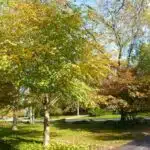Little-leaf Linden, also known as Tilia cordata, is a deciduous tree species that has been cultivated for centuries due to its ornamental value and medicinal properties. This species belongs to the Tiliaceae family and is native to Europe and western Asia. The tree produces fragrant flowers that attract bees and butterflies, making it a valuable addition to any garden or landscape.
As a horticulturist, it is essential to understand how to grow and care for Little-leaf Linden trees properly. These trees require specific environmental conditions, such as well-drained soil, full sun exposure, and regular watering. Additionally, proper pruning techniques can help maintain the tree’s shape while promoting healthy growth. In this article, we will provide you with comprehensive guidelines on how to successfully grow and care for Little-leaf Linden trees so that you can enjoy their beauty in your garden or landscape.
Introduction To Little-Leaf Linden
A single leaf that falls to the ground can be seen as a symbol of passing time, much like the leaves of the little-leaf linden (Tilia cordata) which are known for their distinctive heart shape. This deciduous tree is native to Europe and has been cultivated in North America since the 1700s. It is a member of the Tiliaceae family, which includes other popular trees like basswood and silver linden.
The benefits and characteristics of little-leaf linden are numerous, making it a desirable addition to any landscape. Its dense foliage provides ample shade during hot summer months, while its fragrant flowers attract pollinators like bees and butterflies. The tree’s small size also makes it an ideal choice for urban settings where space is limited. When fully grown, little-leaf lindens typically reach heights between 50 and 70 feet with a spread of up to 35 feet.
When compared to other species within the Tiliaceae family, little-leaf linden stands out for its compact size and overall hardiness. It is more resistant to drought than other species like silver linden, making it an excellent choice for regions with less rainfall. Additionally, its smaller leaves are less susceptible to wind damage when compared to larger-leaved varieties like American basswood. Understanding the Tiliaceae family can help gardeners choose the right species for their specific needs and preferences.
Understanding The Tiliaceae Family
Little-leaf linden, scientifically known as Tilia cordata, is a deciduous tree that belongs to the Tiliaceae family. This family includes about 30 genera and over 400 species of trees and shrubs. The Tiliaceae taxonomy is characterized by their alternate leaves with stipules and flowers with five sepals and petals. Little-leaf linden is native to Europe and western Asia but has been introduced to North America where it is widely cultivated for its ornamental value.
Little-leaf linden is an adaptable tree that can grow in various soil types, including clay, loam, or sand. It prefers moist soils with good drainage and a pH range of 6-8. Little-leaf linden cultivation techniques include planting in full sun or partial shade, depending on the region’s climate. It requires consistent watering during the first year of growth to establish deep roots. Afterward, it can tolerate drought conditions and needs only occasional watering during extended dry periods.
Little-leaf linden thrives in temperate climates with warm summers and cold winters. In its native habitat, it grows in forests or along riverbanks at elevations up to 1,500 meters above sea level. The tree’s natural distribution extends from central Spain to western Russia and from Scandinavia southward to Italy. Its adaptability has led to its widespread introduction throughout North America, where it serves as an ornamental tree in parks, gardens, streetscapes, and residential landscapes alike.
As we continue our exploration of little-leaf linden cultivation techniques, we must also understand its native habitat and distribution patterns better. By doing so, we can gain insight into how this adaptable tree grows under different environmental conditions across various regions worldwide. Let us delve deeper into the natural history of little-leaf linden by exploring its native range and ecological preferences in the subsequent section on understanding the Tiliaceae family.
Native Habitat And Distribution
The native habitat of the Little-Leaf Linden (Tilia cordata) is mainly in Europe and Asia. Its distribution is mainly within the temperate climate zones, with particular preference for moist soils and full sun. In order to successfully grow and care for Little-Leaf Linden, gardeners should provide well-drained, fertile soil and adequate water in direct sun or partial shade. Pruning is also important to maintain a healthy, vigorous tree, and to encourage flowering and fruiting.
Native Habitat
Little-leaf linden, also known as Tilia cordata, is a deciduous tree that belongs to the family Malvaceae. This tree species is native to Europe and western Asia and has been widely introduced in North America as an ornamental tree. In its native habitat, little-leaf linden grows best in moist soils and requires full sun or partial shade for optimal growth.
Habitat preservation plays a crucial role in maintaining the native range of little-leaf linden. These trees grow naturally in forests and woodlands and support various wildlife interactions. The leaves of this tree species provide food for caterpillars, which are important components of many food webs. Additionally, the flowers attract pollinators such as bees, butterflies, and moths. Conservation efforts aimed at preserving natural habitats will ensure the survival of little-leaf linden and its associated wildlife interactions.
In conclusion, understanding the native habitat and distribution of little-leaf linden is essential for growing and caring for this tree species successfully. By providing optimal growing conditions that mimic its natural habitat, horticulturists can help maintain healthy populations of these trees outside their native range. Additionally, promoting habitat preservation practices will ensure that we continue to benefit from the ecological services provided by little-leaf linden and other plant species in our environment.
Distribution
Little-leaf linden has a limited natural range that extends from Europe to western Asia. This tree species has been extensively cultivated in North America as an ornamental tree, but its distribution is still relatively limited compared to other introduced species. Understanding the range limits of little-leaf linden is essential for developing conservation strategies aimed at preserving this tree’s ecological importance.
Conservation efforts aimed at protecting little-leaf linden should focus on preserving its native range and promoting sustainable cultivation practices. In addition to providing food and shelter for various wildlife interactions, this tree species plays a crucial role in maintaining healthy ecosystems. Little-leaf linden helps regulate soil moisture levels and improves air quality by absorbing pollutants and releasing oxygen into the atmosphere.
By understanding the distribution patterns of little-leaf linden, horticulturists can develop effective management plans that prioritize habitat preservation and sustainable cultivation practices. These efforts will ensure that we continue to benefit from the ecological services provided by little-leaf linden while also protecting the natural habitats where this tree species thrives.
Benefits Of Growing Little-Leaf Linden
Little-leaf linden, also known as Tilia cordata, is a beautiful ornamental tree that offers numerous benefits to gardeners and landscapers. One of the most significant advantages of growing little-leaf linden is its ability to provide shade during hot summer days. This tree grows up to 70 feet tall with a dense canopy, making it an excellent choice for shading outdoor living areas and patios. Moreover, little-leaf linden produces fragrant flowers that bloom in late spring, attracting pollinators such as bees and butterflies.
Another benefit of growing little-leaf linden is its versatility in landscaping design. This tree can be used as a focal point or planted in rows to create a natural border. Its dense foliage also makes it an ideal option for privacy screens or windbreaks. Additionally, the wood from little-leaf linden can be used for carving due to its fine texture and even grain.
Finally, little-leaf linden has medicinal properties that have been utilized for centuries. The flowers are used to make tea that acts as a natural sedative and helps alleviate anxiety and tension. These teas are also known to have anti-inflammatory properties that help reduce fever and relieve cold symptoms.
In terms of benefits, little-leaf linden offers numerous advantages that make it an excellent addition to any landscape design project or garden. With its shade-providing abilities, versatility in landscaping design, and medicinal uses, there’s no doubt that this tree has much to offer for those who choose to grow it. As we move forward into the next section on environmental requirements for growing little-leaf linden trees, we’ll explore how best to cultivate these trees so they can thrive in their intended environments.
Environmental Requirements For Growing Little-Leaf Linden
While the benefits of growing little-leaf linden are numerous, some individuals may be hesitant to do so due to concerns about meeting the tree’s environmental requirements. However, with proper care and attention, these trees can thrive in a variety of conditions.
One important factor to consider is sunlight exposure. Little-leaf lindens prefer full sun but can also tolerate partial shade if necessary. When selecting a planting location, ensure that it receives at least six hours of direct sunlight per day. If planting in an area with limited sunlight, consider pruning nearby trees or structures to maximize exposure.
Additionally, temperature requirements should be taken into account. Little-leaf lindens prefer a moderate climate and can withstand temperatures as low as -30°F (-34°C). In areas with harsh winters, providing wind protection for young trees and mulching around the base can help protect them from frost damage.
• Soil Preparation
- Choose well-draining soil with a pH between 6.0 and 7.5.
- Amend soil with organic matter such as compost or aged manure before planting.
• Planting Techniques
- Dig a hole twice as wide and deep as the root ball.
- Place the tree in the center of the hole and backfill with soil.
- Water thoroughly after planting and regularly thereafter.
Incorporating these environmental factors when caring for little-leaf linden will ensure healthy growth and longevity. With proper soil preparation and planting techniques, you can set your tree up for success from the start.
Soil Preparation And Planting Techniques
Soil preparation is an essential step in growing and caring for little-leaf linden trees. The soil should be well-drained, loamy, and have a pH level between 6.0 to 7.5. If the soil is heavy clay or sandy, it’s best to amend it by adding organic matter like compost or aged manure. Raised beds are also a great option for growing little-leaf lindens, as they provide better drainage and prevent waterlogging.
When planting little-leaf linden trees, it’s important to dig a hole twice the size of the root ball and loosen the soil at the bottom of the hole. Place the tree in the hole, making sure that the top of the root ball is level with the ground. Fill in with soil and gently firm it around the tree to ensure there are no air pockets. Mulching techniques can be applied after planting to help retain moisture and suppress weed growth around your little-leaf linden.
Mulching techniques can significantly benefit your little-leaf linden by retaining moisture while suppressing weed growth that competes with your tree’s nutrients. Mulch should be spread three inches deep and kept two inches away from the trunk of your tree to prevent rotting or other issues caused by excess moisture. Proper mulching will also improve soil structure over time as organic matter decomposes into humus, which promotes healthy root development.
Moving on from planting techniques and soil preparation, we come to watering and fertilization methods necessary for keeping your little-leaf Linden healthy. The next section will talk about how much water a young Linden needs during its first year and when it’s time to fertilize your tree for optimal growth.
Watering And Fertilization
After properly preparing the soil and planting the little-leaf linden, it is important to maintain regular watering and fertilization practices. Watering frequency should be determined by the weather conditions in your area. During hot and dry weather, the tree may require more frequent watering. However, overwatering can lead to root rot and other issues. It is best to check the soil moisture level regularly and adjust watering accordingly.
Choosing the right fertilizer is also crucial in promoting healthy growth of the little-leaf linden. Nitrogen-rich fertilizers are recommended as they aid in leaf development and overall growth of the tree. Fertilizer application should be done during the growing season, which typically begins in late spring through summer. It is important to follow package instructions on how much fertilizer to apply and avoid overfeeding as it can damage roots.
Regular watering and fertilization not only promotes healthy growth but also helps prevent pests and diseases from affecting the tree. With proper care, the little-leaf linden can live for many years and provide a beautiful addition to any landscape. In order to further enhance its visual appeal, pruning and shaping techniques can be applied to maintain a desired shape or form.
Pruning And Shaping Techniques
Pruning and Shaping Techniques:
Pruning and shaping little-leaf linden is an essential aspect of maintaining its health and beauty. Neglecting to do so can lead to a tangled growth pattern, making it difficult to manage. However, pruning and shaping these trees can be a daunting task for inexperienced gardeners. Fear not, as with the right top pruning tips and creative shaping ideas, you can keep your little-leaf linden looking beautiful year-round.
Top Pruning Tips:
- Always use sharp and clean tools when pruning.
- Prune during late winter or early spring before new growth begins.
- Sub-list:
- Avoid pruning during periods of drought or excessive heat.
- Remove no more than 1/3 of the tree’s total canopy in one season.
- Cut back any dead or diseased branches first before moving on to live ones.
- Sub-list:
- Remove any branches that grow inward towards the center of the tree.
- Thin out crowded areas to improve air circulation.
Creative Shaping Ideas:
- Little-leaf linden has a natural pyramidal shape that can be further accentuated through selective pruning.
- Sub-list:
- Trim off lower branches to create a clear trunk for an elegant look.
- Create a more formal shape by removing all but one central leader branch.
Incorporating these top pruning tips and creative shaping ideas will help your little-leaf linden thrive. However, even with proper care, pests and diseases can still occur. In the following section, we will discuss common pests and diseases that affect little-leaf linden trees.
Common Pests And Diseases
It is important to be aware of the potential pests and diseases that may affect little-leaf linden trees. One common pest is the Japanese beetle, which feeds on the leaves and can cause significant damage. Symptoms include skeletonized leaves and an abundance of beetles on the tree. Another pest to look out for is the Linden borer, which can cause wilting and branch dieback. Identifying these pests early on can help prevent further damage.
In terms of diseases, little-leaf linden trees may be susceptible to leaf spot diseases such as anthracnose, which causes brown spots on the leaves. Powdery mildew is another disease that may occur, resulting in a white powdery substance appearing on the leaves. It is important to note that while these diseases may not necessarily kill the tree, they can weaken it over time if not addressed.
Prevention and control methods for pests and diseases include proper maintenance practices such as regular pruning and sanitation of pruning tools to prevent disease spread. Insecticides can also be used for pest control, but it is important to follow instructions carefully and consider using natural or organic options if possible. For disease prevention, ensuring good air circulation around the tree and avoiding overhead watering can help reduce risk.
Moving forward with little-leaf linden care, it is crucial to keep an eye out for any signs of pests or diseases in order to address them promptly. Prevention and treatment methods can go a long way in maintaining a healthy tree that will continue to thrive in your landscape for years to come.
Prevention And Treatment Methods
Much like preventing illness, maintaining the health of your little-leaf linden tree requires a proactive approach. Prevention techniques are key to avoiding common problems such as pests and diseases that can harm or even kill your tree. One of the most effective prevention methods is ensuring proper irrigation – this means making sure the soil around your tree stays moist but not waterlogged. Additionally, pruning can help prevent pest infestations by removing dead branches that attract insects.
Despite our best efforts to prevent problems, sometimes treatment options become necessary to restore the health of our little-leaf linden trees. One common problem is powdery mildew, which can be treated with a fungicide spray applied to both the leaves and surrounding soil. Another issue is leaf spot disease, which can be addressed through sanitation measures such as raking up fallen leaves and avoiding overhead watering.
It is important to remember that prevention techniques should always be prioritized over treatment options when caring for your little-leaf linden tree. However, if issues do arise, there are effective solutions available to solve many common problems. By remaining vigilant and taking proactive steps toward maintaining the health of your tree, you can avoid having to resort to treatment options altogether. In the next section we will discuss propagation techniques that will help you expand your little-leaf linden collection with confidence.
Propagation Techniques
In addition to growing little-leaf linden from seed, there are two primary propagation techniques: air layering and stem cutting. Air layering is a technique where a branch is partially cut and held open with a toothpick or wire, and then wrapped in damp sphagnum moss. Roots will grow from the area above the cut, allowing for a rooted cutting that can be removed and potted after several months. This method works well for larger branches that cannot be easily propagated through stem cutting.
Stem cutting is another common propagation technique for little-leaf linden. Cuttings should be taken in early summer when the tree is actively growing. Take 6-8 inch sections of new growth that have not yet formed woody tissue. Remove any leaves from the lower half of the cutting, dip it in rooting hormone, and plant it in well-draining soil or propagation mix. Keep the soil moist but not overly wet, and place the pots in bright but indirect light until roots form.
Propagation can be a rewarding way to increase your stock of little-leaf linden trees. Both air layering and stem cutting can produce healthy new plants if done correctly. Once you have rooted a new tree, it may take several years before it is large enough to transplant into its permanent location. The next section will cover how to prepare your little-leaf linden for transplanting and moving to ensure successful establishment in its new home.
Transplanting And Moving Little-Leaf Linden
After successfully propagating little-leaf linden, the next step is to ensure that they are moved into their permanent growing location. Transplanting techniques can vary depending on the size of the tree, but it is important to remember that lindens prefer well-draining soil and should not be planted too deeply. When moving small saplings, it is best to dig a hole twice as wide as the root ball and plant at ground level. For larger trees, it may be necessary to hire a professional to ensure proper transplanting.
The best time to move little-leaf linden is in early spring before new growth begins or in late fall after leaves have fallen off. During these times, the tree will experience less stress from being transplanted and will have more time to establish roots before summer heat or winter cold sets in. It is also important to water the tree thoroughly after transplanting and monitor its growth closely for any signs of stress.
In addition to proper transplantation, seasonal care tips are crucial for maintaining healthy little-leaf linden trees. Pruning should be done in late winter or early spring before new growth appears, and dead or damaged branches should be removed as soon as they are noticed. Fertilizer can be applied in early spring and again in early fall, but it is important not to over-fertilize as this can lead to excessive growth and weakened branches. By following these care tips, little-leaf linden trees can thrive for years to come.
Seasonal Care Tips
In the spring, little-leaf linden trees should be fertilized twice with a slow-release granular fertilizer. In addition, they should be inspected for pests and diseases and pruned as needed. During the summer months, little-leaf linden trees should be watered deeply and regularly, mulched to retain moisture, and pruned to promote vigorous growth. Lastly, they should be monitored for signs of drought stress, pests, and diseases.
Spring Care Tips
As spring approaches, it is important to pay attention to the little-leaf linden in your garden. Spring pruning is essential for maintaining the tree’s shape and promoting healthy growth. Remove any dead or diseased branches before new growth appears, and thin out any crowded areas to improve air circulation. This will also help prevent pest infestations.
Pest control is another important aspect of spring care for little-leaf lindens. Aphids, scale insects, and spider mites can all pose a threat to the health of your tree. Regularly inspect the leaves and branches for signs of infestation, such as sticky residue or distorted foliage. If necessary, treat with an appropriate insecticide or seek advice from a professional horticulturist.
By following these spring care tips, you can ensure that your little-leaf linden remains healthy and vibrant throughout the growing season. Proper pruning and pest control will not only benefit the tree itself but also provide a beautiful addition to your garden for years to come.
Summer Care Tips
As seasonal changes occur, it is important to adapt your care practices accordingly to maintain the health and beauty of your little-leaf linden tree. After spring pruning and pest control measures have been taken, attention should shift towards summer care. One essential aspect of this is mulching. Mulching provides numerous benefits for your little-leaf linden, including protecting roots from extreme temperatures, retaining moisture levels in the soil, and suppressing weed growth. In addition to these benefits, mulch also enhances the aesthetic appearance of garden beds.
Another critical component of summer care for little-leaf lindens is continued pest control strategies. As temperatures rise and humidity increases, pests such as Japanese beetles and leafhoppers become more active and can quickly infest your tree if left unchecked. Regularly inspecting leaves and branches for signs of infestation is crucial for early detection and treatment. Depending on the severity of the problem, various insecticides or organic methods may be necessary to protect your tree.
In conclusion, proper summer care practices are essential for maintaining the optimal health and appearance of your little-leaf linden tree. Mulching benefits provide a protective layer for its roots while also adding visual appeal to garden beds. Continued pest control strategies are crucial in preventing infestations that can weaken or harm the tree’s growth. By following these tips, you can enjoy a thriving little-leaf linden throughout the summer months and beyond.
Frequently Asked Questions About Little-Leaf Linden
Little-leaf linden is a beautiful tree that can reach up to 70 feet tall and 50 feet wide. It has oval-shaped leaves, fragrant yellow flowers, and a grayish-brown bark. However, like any other plant, it can face some issues that may affect its growth and health.
One of the most common problems seen in little-leaf linden trees is aphid infestation. These small insects feed on the sap of the tree’s leaves and cause them to curl or become discolored. To prevent this problem, it’s recommended to keep the tree healthy by watering it adequately and providing enough nutrients through fertilization. In case of an infestation, spraying with insecticidal soap or using natural predators like ladybugs can help control the issue.
Little-leaf linden thrives in full sun to partial shade and moist soil conditions. It’s native to Europe but can grow well in USDA hardiness zones 3–7 in North America. It prefers slightly acidic to neutral soil pH levels between 6.0–7.5. When planting little-leaf linden, make sure to choose a spot that provides enough space for its mature size and good air circulation around its branches. With ideal climate conditions, proper care, and timely maintenance practices, your little-leaf linden will grow into a majestic tree that beautifies your landscape for years to come.
Looking for more information about growing and caring for little-leaf linden? In the following section, we’ll cover some practical tips on how to ensure your tree thrives all year round!
Conclusion: Growing And Caring For Little-Leaf Linden
In order to successfully grow and care for little-leaf linden, it is important to understand its specific needs. This tree thrives in full sun or partial shade and prefers moist, well-drained soil. When planting, make sure to give the tree enough space to grow and avoid planting too close to buildings or other trees.
Pruning techniques are also important for maintaining the health and appearance of little-leaf linden. It is recommended to prune in late winter or early spring before new growth appears. Remove any dead or diseased branches, as well as any crossing or rubbing branches. Regular pruning will help maintain a strong structure and prevent the tree from becoming too dense.
Pest control strategies for little-leaf linden include regular monitoring for aphids, scale insects, and Japanese beetles. Insecticidal soaps can be used to control these pests, but it is important to follow label instructions carefully. Additionally, keeping the area around the tree clean of fallen leaves and debris can help prevent pest infestations.
Overall, growing and caring for little-leaf linden requires attention to detail and consistent maintenance practices. By providing proper watering and fertilization, utilizing appropriate pruning techniques, and monitoring for pests regularly, this beautiful tree can thrive in your landscape for years to come.
Conclusion
In conclusion, growing and caring for Little-Leaf Linden requires a deep understanding of its environmental needs, growth habits and seasonal requirements. As a member of the Tiliaceae family, this beautiful tree has many benefits including its hardiness, ornamental qualities and ability to attract pollinators such as bees and butterflies.
To successfully grow Little-Leaf Linden, it is important to ensure it is planted in well-drained soil with plenty of sunlight. Transplanting should be done carefully to avoid root damage and seasonal care should include regular watering, pruning and pest control measures. As horticulturists, we must recognize the value of this tree species in our urban landscapes and work towards preserving it for future generations. The beauty of Little-Leaf Linden lies not only in its striking appearance but also in its contribution to our environment. As the saying goes, “The best time to plant a tree was 20 years ago. The second-best time is now.” Let us take action today towards growing and caring for Little-Leaf Linden trees.
Image Credits
- “Yellow little leaf lindens by Markle Hall and Skillman Library” by Jason Alley (featured)





























